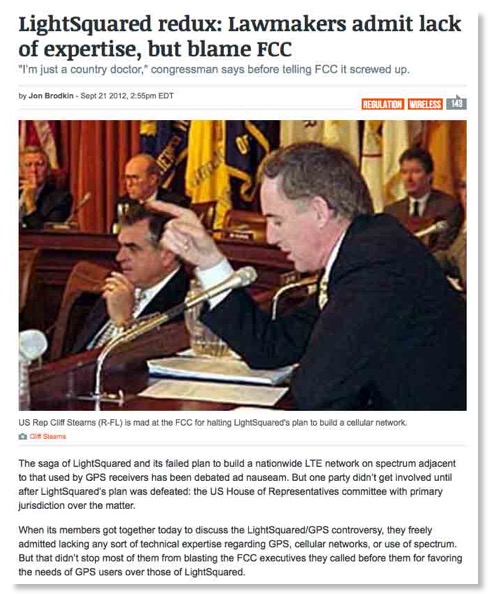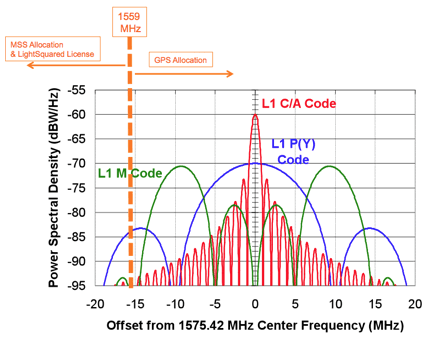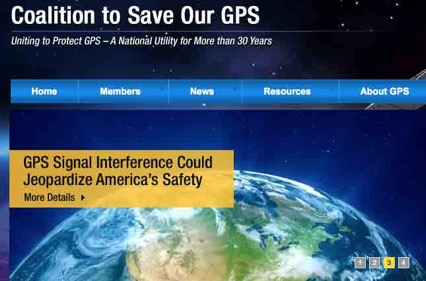Partisanship and Spectrum Policy

Here is some of the coverage of a recent hearing of the Subcommittee on the GPS/LightSquared issue by our fellow bloggers at Ars Technica.

The hearing, video of which is available below, had the committee members chewing out my former colleagues International Bureau Chief Mindel De La Torre and OET Chief Julius Knapp, on why they halted LightSquare’s system. They repeated insisted on yes/no answers on questions that were complex and had not straightforward answers. Here is an example:
Rep. Stearns: “Each operator has the responsibility to stay in its lane, using your analogy, is that correct?”
De La Torre: "Yes."
Rep. Stearns: “When one operator veers into the adjacent lane, is it the responsibility of an operator to correct its course, or is it the role of the FCC to patrol the highway? Briefly."
De La Torre: “Really, what was happening here was…”
Rep. Stearns: “Isn’t it the responsibility of the operator to correct its course? Yes or no?”
De La Torre. “It’s a difficult question. That’s the question that's before us, and I think…”
Rep. Stearns: “Yes or no? I'm asking for a yes or no, to the best of your ability.”
De La Torre: “I think they do have a duty to respond…”
Rep. Stearns: “OK, I'm going to take that as a yes.”
One of the odder exchanges was reported by Ars Technica as:
US Rep. Brian Bilbray (R-CA), an avid boater, said he understands the importance of GPS for safely finding one’s way home. But, "on the flip side," he said, more spectrum devoted to iPhones can improve safety too. "Just as much as GPS is essential there are thousands of people offshore every day that would have a huge safety factor if they could pull up an iPhone, and from 200 miles offshore be able to call for emergency services," he said. "This has a safety issue going both ways."
Rep. Bilbray, conventional cell phones including iPhone, do not work and will never work from “200 miles offshore”. MSS systems like Iridium and the service offered by LightSquared’s presently operational MSS system (designed to share spectrum with their proposed but threatened terrestrial ATC system) do. It is ironic that what triggered the current imbroglio was LightSquared trying to offer cellphones that were terrestrial only as opposed to bulkier ones previously authorized by FCC that included both MSS and terrestrial(ATC) service.
Months before the Republicans of the Energy & Commerce Committee came late to the GPS/LS issue, their fellow Republicans on the House Armed Services Committee criticized FCC for the exact opposite reason: why did they ever consider authorizing LightSquared as opposed to kowtowing to GPS interests and their self-centered view of spectrum policy.
So House Republicans, which is it? Is the current FCC wrong for considering LightSquared at all or it is wrong for not defending them again GPS interests? Perhaps both reasons are good enough to bash the present FCC and by implication the White House? Note that there were multiple FCC decisions under Chmns. Powell and Martin that supported ATC and LightSquared and its predecessors and that GPS interests participated in those decisions without major complaints at the time.
On September 13th, the Committee’s Subcommittee on Communications and Technology dumped on NTIA at the behest of cellular interests.
This time NTIA’s Karl Nebbia was beat up by the subcommittee members who were really angry over the PCAST report that Karl probably personal dislikes but had to defend as part of his job. While the free trade press did not cover this event, Keystone Public Affairs has posted this summary.
In both September hearings the committee’s subcommittees were trying to make partisan hay out of US spectrum management issues. The reality is that there are major problems in our present spectrum policy decision making in the US as any longtime reader of this blog has read multiple times. The roots go back decades and are bipartisan in nature. What we really need to to keep spectrum policy bipartisan as it generally has been and work together to improve the process.
Danger FUD Attack!
The Bizarre Case of LightSquared and GPS
The Bizarre Case of LightSquared and GPS
FUD (fud) n. 1. a method of disparaging an opponent by avoiding the specifics of an issue and creating a smoke screen of “fear, uncertainty, and doubt”
The spectrum struggle of LightSquared to obtain permission to use its spectrum for terrestrial broadband use in addition to the mobile satellite use it is already licensed for looks like it will be a classic one at FCC, bringing back elements of previous epic struggles like Northpoint/MVDDS, UWB, AWS-3/M2Z, and PCS H block. These all involved a proposed new spectrum use that threatened incumbent users with possible interference.
To make matters worse, in 3 of the above cases the new entrant would also be competing with the incumbent, a combination sure to infuriate any incumbent with an FCBA directory at hand and the funds to wage a protracted legal battle. The fact that DirecTV was on “the auction block” during the Northpoint/MVDDS battle and T-Mobile was also during the AWS-3 battle meant that those two firms had extra incentive to assuage the fears of potential multibillion dollar buyers by waging a scorched earth policy before FCC. Now we see the GPS industry doing the same with respect to their neighbor LightSquared and NTIA and the military are joining in. The GPS industry is taking advantage of the “ex parte loophole” to lobby IRAC members and NTIA to press FCC off the public record.
(The 12/13/10 USGIC letter to NTIA is in the record of this proceeding only because an OET staffer mysteriously got a copy from NTIA and took the initiative to place it in the file. Had NTIA not sent a copy of the actual letter to the OET staffer, the content of this letter might never have become public. Why doesn’t NTIA reveal this outside lobbying clearly intended to influence FCC? Transparency is a big issue for the Department of Commerce, shouldn’t NTIA be a team player over there? This week Secretary Locke said in Brazil, “we hope the Brazilian government will continue its efforts to build a business climate with more transparency and a more consistent regulatory environment”. Let’s see how well NTIA can do in the transparency area!)

Speaking at the Air Force Association's Air Warfare Symposium in Orlando, Gen William Shelton says the 4G mobile broadband network in the works from LightSquared would spread 40,000 towers - and interference - across the US.
"Within three to five miles on the ground and within 12 miles in the air, GPS is jammed by those towers," Shelton says. "If we allow that system to be fielded and it does indeed jam GPS, think about the impact. We're hopeful we can find a solution, but physics being physics we don't see a solution right now. Where did these numbers come from? A lot of people think he went “hook, line, and sinker” for data from a report from Garmin, not exactly a high end GPS manufacturer. “Physics being physics” - a great sound bite, but does it belong in the policy deliberations here?
In this proceeding as well as the 4 mentioned above, the opponents of progress demonstrated that a poorly designed new system would cause interference to their system and then made the extrapolation that ANY such new system must cause interference no matter how it is designed! To make matters worse, Gen. Shelton and the GPS industry repeatedly use the term “jam”. Google now gets 175,000 hits on the terms “GPS”, “jam” and LightSquared”! Note that a recent joint USGIC/LightSquared joint filing uses the more objective and technically correct term “potential for overload interference/desensitization to GPS receivers, systems, and networks”.
To help spread FUD, several companies and organization have formed a group, Coalition to Save Our GPS (CSOG). In addition to GPS companies Garmin and Trimble, the group includes: the Aeronautical Repair Stations Association, Air Transport Association, Aircraft Owners and Pilots Association (AOPA), American Association of State Highway and Transportation Officials, American Rental Association, Associated Equipment Distributors, Association of Equipment Manufacturers, Case New Holland, Caterpillar Inc., Edison Electric Institute, Esri, General Aviation Manufacturers Association, Deere & Company, National Association of Manufacturers, and OmniSTAR.
Readers may recall that AOPA is the group that has successfully pressured FAA for 20 years not to adopt ICAO ILS receiver standards that prevent receiver-generated intermodulation because they would rather that the whole burden of preventing the problem be on the FM broadcast industry. These ILS receiver standards have been adopted in most other countries but would inconvenience AOPA members who might wish to use 20 year old ILS receivers and feel they have a constitutional right to use anything the FAA ever approved!
Let’s see what the spectrum in question looks like:

As can be seen, most of the GPS energy is in its allocated spectrum above 1559 MHz but the blue colored L1 P(Y) has some noticeable power below 1559 MHz. While the L1 C/A code is what is received in consumer GPS receivers, the P(Y) signal was intended only for military use and is often encrypted. The latest GPS satellites use the L1M code which stays within the allocation. As an excellent e-book from Trimble points out, “Because this code (P(Y)) modulates both the L1 and L2 carriers, some advanced civilian receivers can play sophisticated games with the two frequencies to help eliminate errors caused by the atmosphere”. Thus the sophisticated real-time kinematic (RTK) receivers with centimeter accuracy use a piece of Government spectrum that was not planned for civilian use; with NTIA-authorized transmitters but receivers that never went through the NTIA spectrum planning process. In addition, L1 consumer grade receivers with marginal filters in their front ends could be subject to overload interference/desensitization from unexpectedly strong adjacent channel signals.
The first problem is related to FCC and NTIA not paying enough attention to the fact that a large nongovernment community was using an NTIA authorized Government system in ways that were not planned. This latter problem is oddly similar to the PCS H block problem and the AWS-3/M2Z problem and deals with reasonable present and long term expectations for receiver filters. Normally in an exclusively government band like GPS’ this would have been decided by NTIA as part of its normal process, but the commercial products did not have to met the receiver specs filed at NTIA by the Air Force. An old saying in the spectrum management business is that “transmitters do not use spectrum, receivers do”. While FCC generally does not regulate receivers, NTIA does but commercial GPS receivers fell in the interagency gap.
As part of their FUD attack, the GPS community is stating conditions (demands?) for any outcome:
Further, the FCC's, and NTIA's, finding that "harmful interference concerns have been resolved" must mean "resolved to the satisfaction of pre-existing GPS providers and users.”
Resolution of interference has to be the obligation of LightSquared, not the extensive GPS user community of millions of citizens. LightSquared must bear the costs of preventing interference of any kind resulting from operations on LightSquared's frequencies. GPS users or providers should not have to bear any of the consequences of LightSquared's actions.
So according to their first point, “public interest” should no be longer the criteria for spectrum policy decisions. 77 years after the passage of the Communications Act we should designate certain spectrum users, in this case not even licensees, with veto power over certain spectrum decisions. I bet the whole NAB membership will be next in line for such veto power or be insulted if they don’t get it first!
In the second point it appears that as in the case of the aging ILS receivers that AOPA and FAA are protecting, any GPS receiver ever sold must be protected for the rest of its natural life. FCC is nearing the end of a 20 year transition of narrowbanding VHF and UHF land mobile spectrum. Would a 20 year transition for upgrading GPS receiver filters be slow enough be acceptable to CSOG? Since AOPA is involved, will they insist that spectrum efficiency wait until the last current model GPS dies a natural death as they have in the ILS case? Would groups like AOPA object to adjacent band signal rejection standards for new GPS units? Would that constitute the dread “bear(ing) any of the consequences of LightSquared decisions”? Are there any compensating public interest benefits of what LightSquared proposes in the eyes of CSOG?
Despite what Gen. Shelton says about “physics”, some of the building blocks of a solution are clear:
• LightSquared could carefully shape the beam and particularly the vertical pattern of their antennas to limit power flux density (pfd) on the ground and in the air. The alarmist Garmin report that Gen. Shelton appears to have based his statements on assumed 32 dBW EIRP for the LightSquared system and did not consider any beam shaping that would limit pfd on the ground or in the air. Thus it ignored all the lessons of the Northpoint/MVDDS controversy.
•The GPS community could switch to higher performance filters in their new receiver front ends. Such a switch is not painless but filter technology, not unlike digital semiconductor technology improves with time and will continue to improve.
•LightSquared could shaped their spectrum and stay away from the GPS lower edge in their initial implementation when they have fewer cell sites and hence need more power. The shape could change as the GPS receiver population improves with time and as increased cell site density decreases base station power requirements.
Meanwhile read for yourself what is happening. For procedural reasons this is not a docketed proceeding, but is on the obscure International Bureau Electronic Filing System (MyIBFS). Here is a direct link. MyIBFS was clearly not intended for this type of “food fight” and may collapse under the weight of the consumer comments CSOG is soliciting- it is already getting difficult to use for this issue. Fortunately MyIBFS is so user unfriendly that individuals probably can’t file directly and CSOG is asking consumers to e-mail a general FCC address which probably will be swamped.
Meanwhile, LightSquared and USGIC are meeting as directed by FCC to try to resolve their differences. FCC and the public get monthly views - on the chaotic MyIBFS site - of what is happening. It is sort of a negotiated rulemaking without the safeguards of the Negotiated Rulemaking Act. Negotiated rulemakings have never worked at FCC, but such 2 sided negotiations have had problems also. In the 1980s FCC told educational FM licensees to solve their power increase differences with adjacent band TV channel 6 licensees (another adjacent band power increase problem!) But the Commission had to fine tune the negotiated agreement, finding that agreements between the directly affected parties do not always reflect the overall public interest.
UPDATE
On March 25 the Deputy Secretaries of DoD and DOT wrote to Chmn. Genachowski on the public record - since unlike NTIA they do not “share jurisdiction” with FCC. They complain that their agencies are not included “in the initial workplan or its key milestones”. They say “we are concerned with this lack of inclusiveness regarding input from federal stakeholders”.
Wow! Given a choice between a seat - or 2 seats in this case - on IRAC or being invited to USGIC/LightSquared powwows I know which I would choose! IRAC members get drafts of FCC decisions that no other outsider sees and generally can make nonnegotiable demands on FCC as a price for coordination. Notwithstanding the fancy language about NTIA’s role, NTIA almost always acts as the IRAC’s messenger/law firm and types the IRAC demands on Commerce Department letterhead for transmission to FCC.
On the other hand, the negotiated rulemaking approach above would avoid DoD and DOT being left out int he cold. But are DoD and DOT willing to stop using the “NTIA loophole” to funnel private firms issues to FCC through NTIA off the public record? Will DoD and DOT commit to full transparency in this proceeding except for valid national security issues?
NEW UPDATE
FCC has now place the comments in docket 11-109 so they are available by way of ECFS. Despite its many quirks, ECFS has much better search facilities than the obscure MyIBFS which clearly was not intended for such large proceedings.




![Validate my RSS feed [Valid RSS]](valid-rss-rogers.png)

